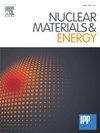ERO2.0 predictions of nickel migration in the JET ITER-Like Wall
IF 2.3
2区 物理与天体物理
Q1 NUCLEAR SCIENCE & TECHNOLOGY
引用次数: 0
Abstract
Nickel transport in the Joint European Torus with the ITER-like wall (JET-ILW) is predicted using the 3D Monte-Carlo code ERO2.0, simulating the erosion and deposition of impurities in 3D geometry and utilizing hydrogenic background plasmas generated by the 2D edge fluid code EDGE2D-EIRENE. Charge exchange fluxes are obtained from the 3D neutral Monte-Carlo code EIRENE, which are modified to account for the shielding of the vacuum vessel wall by protruding plasma facing components, such as guard limiters. ERO2.0 is used to predict Ni erosion and deposition profiles for the first three JET-ILW campaigns weighted for the plasma operation time.
The primary location of nickel erosion on the Inconel vacuum vessel wall is predicted to be on the low-field side close to the midplane. The eroded nickel is predicted to be transported onto the entrance of the high-field side divertor, due to the scrape-off layer flows, where it is predicted to deposit and to form a layer on tile 1. The peak thickness of the predicted deposit layer is of the order 1-2/cm, a factor of six higher than measured in post-mortem tile analysis.
求助全文
约1分钟内获得全文
求助全文
来源期刊

Nuclear Materials and Energy
Materials Science-Materials Science (miscellaneous)
CiteScore
3.70
自引率
15.40%
发文量
175
审稿时长
20 weeks
期刊介绍:
The open-access journal Nuclear Materials and Energy is devoted to the growing field of research for material application in the production of nuclear energy. Nuclear Materials and Energy publishes original research articles of up to 6 pages in length.
 求助内容:
求助内容: 应助结果提醒方式:
应助结果提醒方式:


